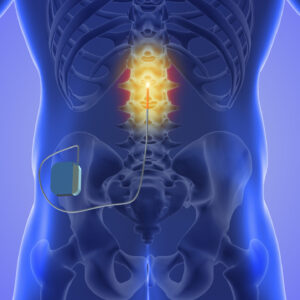Spinal Cord Stimulators
Back pain is a debilitating condition that affects hundreds of millions of people around the world. Around 23% of adults live with chronic back pain that reduces their quality of life. One of the ways to alleviate this pain is to implement a spinal cord stimulator. This device sends electrical pulses to the spinal cord and eases the negative sensations. Understanding how it works can help you make a decision about your treatment options.
What Is a Spinal Cord Stimulator?
A spinal cord stimulator is a medical device that can reduce back pain. Studies demonstrate that this option can be more effective than conventional pain relief methods. In most cases, your doctor can recommend the stimulator if other pain relief tactics don’t yield the desired results.
The spinal cord stimulator consists of three components:
- Pulse generator – a small pacemaker-like device that is usually implanted in the abdomen or buttock region.
- Electrodes – thin insulated wires that bring the electrical impulse to the nerves along the spinal cord. They are implanted between the vertebrae (backbones of the spine) and the spinal cord.
- Remote control – a device that allows the patient to initiate the electrical impulse when the pain intensifies.
If you choose to have a spinal cord stimulator surgery, the treatment will begin with a trial period. A surgeon will insert temporary electrodes into the targeted area and test the effectiveness of the stimulation. If the trial is successful, you can undergo implantation.
How Do Spinal Cord Stimulators Work?
While the exact mechanism of spinal cord stimulation requires more exploration, the gate control theory offers a viable explanation. According to this theory, spinal cord stimulators work by interfering the with signals that your spinal nerves are sending to the brain.
The main types of spinal cord stimulators are:
- Implantable Pulse Generator (IPG) – the conventional battery-operated device that works until the battery runs out. To replace the battery, the patient needs another surgery.
- Rechargeable Pulse Generator – this device has a battery that can be recharged without additional surgery. It can also produce a higher electrical output than the conventional IPG.
- Radiofrequency stimulator – an older version of the stimulator that has rechargeable batteries outside the body.
All of these devices have a remote control that helps you regulate the frequency and intensity of the impulse. Your doctor can help you decide which stimulator is the best option.
Surgery and Recovery
The implantation surgery is an outpatient procedure, which is done under general anesthesia.
Your physician may recommend training with a physical therapist to teach you how to take part in everyday activities without putting stress on your back. You will have to avoid full baths, serious physical activity, and abrupt movements for several weeks after the surgery. In general, the spinal cord stimulator recovery time is between six and eight weeks.
Living with a spinal cord stimulator can come with several limitations, including:
- Turning off the stimulator while driving
- Avoiding MRI scans (some devices aren’t compatible with the machine)
- Showing medical certificates at airports because the stimulator may show up on scanners
Other than these nuances, the device doesn’t usually interfere with your everyday activities.
Choosing the Right Back Pain Treatment
The implantation of a spinal cord stimulator can help ease the pain related to several conditions, including failed back surgery syndrome, arachnoiditis, spinal cord injuries, and nerve-related pain.
At the Pain Institute of Middle Tennessee, we have a team of board-certified surgeons to develop a plan to help manage your pain. Request an appointment today.